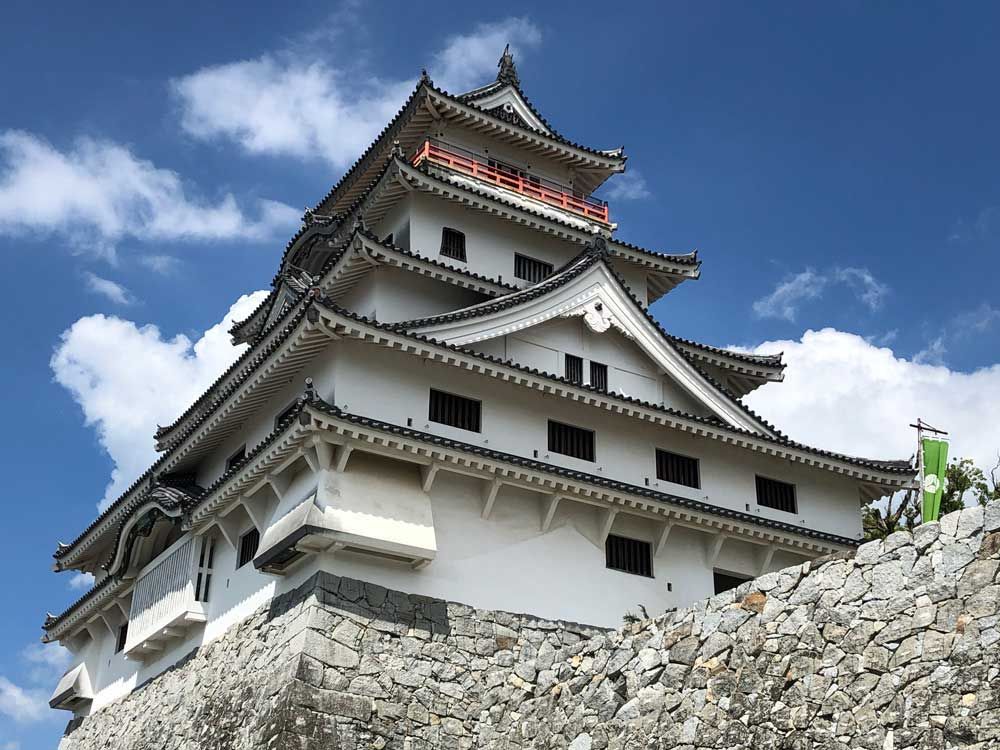Karatsu City is located in the northern part of Saga Prefecture in Kyushu, Japan. The small city is especially famous for its yearly Karatsu Kunchi festival in the first week of November and Karatsu ware, pottery that is beautiful in its simplicity and often used for the tea ceremony.

Ancient Harbor
Karatsu took an important position for maritime traffic since ancient times due to its location close to the mainland. Trade with foreign countries, especially with China and Korea, was very active since ancient times. Moreover, Karatsu’s name came from this fact: the writing of “Kara 唐” is the ancient name of China, and “Tsu津” means port, so the Karatsu ensemble means “the port for ships leaving for China”. Thanks to its port, Karatsu was a prosperous city until the 1920s.
Sightseeing in Karatsu
Karatsu still has plenty of important historical heritage. Here are the best sights in Karatsu;
Karatsu Castle
Karatsu Castle, the symbol of the city, faces the Karatsu Bay. The castle was built in 1609 by one of the Toyotomi lords, Terazawa, and the ocean was used as a natural moat. After the Meiji Restoration, the castle was demolished in 1877, and a park was created in its place. The present dungeon, a reconstruction of the original dungeon, was built in 1966. The castle exhibits the history of Karatsu, a Karatsu pottery collection, and especially the panoramic view from the castle observatory is a must-see.
Access: 20 min. walk from Karatsu station.
Admission: 500 yen for adults, 250 yen for schoolchildren
Opening hours: 9 am-5 pm (last entry 4.30 pm)
Nijino Matsubara (pine forest)
Nijino Matsubara is a pine forest of about 240ha. The forest was planted by the feudal lord Terazawa (lord of Karatsu Castle) to protect the city from the strong winds coming from the ocean.
Takatori’s Old Residence
The former Takatori residence was that of Koreyoshi Takatori (1850-1927), who was the owner of the Kijima Coal Mine and other coal mines in Karatsu. Two buildings are located on a large site of about 2,400m2 along the southwest coast of Karatsu Castle. Inside the residence, you can see a mixture of Western and Japanese design and style and there is also a Noh scene.
Access: 15 min walk from Karatsu Station
Entrance: 520 yen for adults, 260 yen for schoolchildren
Opening hours: 9 am-5 pm (last entry 4.30 pm)
Karatsu Pottery
Karatsu’s pottery is earthenware. The history of Karatsu pottery dates back to the 16th century. Karatsu pottery flourished until the Edo period as the official pottery of the clan in charge, and also for the production of plates for the tea ceremony. Unfortunately, from the Meiji period, Karatsu pottery declined. However, when the living national treasure Nakasato Muan (1895-1985) revived the long-forgotten ancient Karatsu techniques of the Momoyama period and early Edo period, it was resurrected and the number of potters increased. There are now about 70 potteries in the city.
Karatsu Kunchi Karatsu Kunchi Float Exhibition Hall
Karatsu Kunchi is an annual festival of the Karatsu Shrine which takes place every year from November 2nd to 4th. The purpose of this festival is to celebrate its foundation which dates back to 755. It is said that the first festival took place between 1661-1673. On the day of the festival, 14 floats called Kunchi parade through the streets. Most of the floats were developed between 1819 and 1876.
Next to the Karatsu Shrine, Karatsu Kunchi Karatsu Kunchi’s chariot exhibition hall (Hikiyama) exhibits the 14 floats used for the festival.
Access: 10 min. walk from Karatsu Station.
Entrance: 310 yen for adults, 150 yen for schoolchildren
Opening hours: 9 am-5 pm (last entry 4.40 pm)
Yobuko Morning Market and Yobuko Squid
Yobuko, located 30 min by local bus from the center of Karatsu, is a small fishing village. We can find and taste a wide variety of fish, but the most famous one is the Yokubo squid that is caught in the Genkai Sea. We can of course eat it as sashimi (raw). When it is very fresh, the squid is still transparent. You can also taste it in restaurants in downtown Karatsu.
Access: 30 min by local bus from Karatsu station
Opening hours: 7.30 am-noon
Nanatsugama Sea Caves in Yobuko
This picturesque place was formed on the rocky cliffs of the Genkai Sea after many years of a rough sea. A part of the hollowed-out rocky cliff has 7 caves that look just like ovens, hence the name 7 ovens, Nanatsu-gama. From Yobuko port, you can join a 40 min cruise to see these cliffs up close.
Access: 30 min by local bus from Karatsu station.
Admission: 1800 yen for adults (40min cruise)
Opening hours: 9.30 am-4.30 pm
Local Food of Karatsu
Every region in Japan has its own local delicacies. In Karatsu, river crab is one of those local specialty dishes. You can eat it as it is with the kanimiso (orange miso-like substance) and white meat being the best parts, or you can eat it in kanemeshi, which is crab meat over rice. Furthermore, beef from the black Japanese cow that is raised in Saga prefecture and great meat for shabu shabu is a must-try when you are in the region.
Local Souvenir of Karatsu
Obviously, when you go to Karatsu the one thing you should buy is Karatsu ware. While it may not be very colorful as it retains the colors of the soil that was used to produce the pottery, it is very simple and classic and goes well with many tasteful interiors. Pottery connoisseurs have praised Karatsu ware for its design, and it makes for a perfect present for those who like the Japanese minimalist style.
Your Japan Tour
As seasoned Japan experts, we can help you create your perfect Japan tour including destinations like Karatsu. Contact us to start planning your unforgettable holiday to this fascinating country full of once-in-a-lifetime experiences, culture, history, nature, and delicious food!

